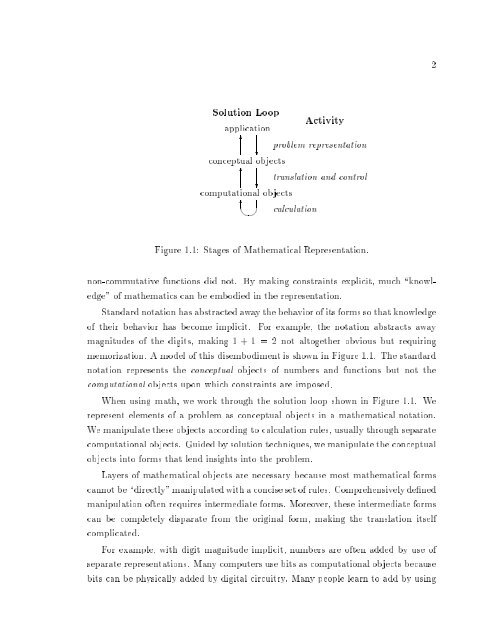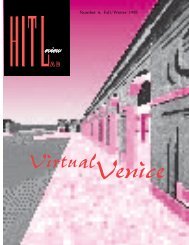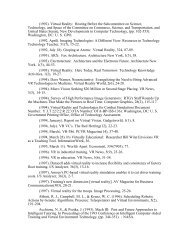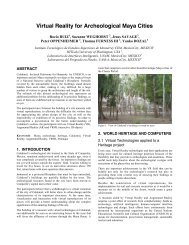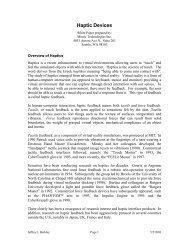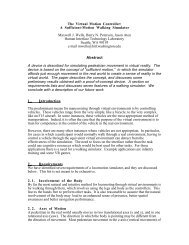A Calculus of Number Based on Spatial Forms - University of ...
A Calculus of Number Based on Spatial Forms - University of ...
A Calculus of Number Based on Spatial Forms - University of ...
You also want an ePaper? Increase the reach of your titles
YUMPU automatically turns print PDFs into web optimized ePapers that Google loves.
2<br />
Soluti<strong>on</strong> Loop<br />
applicati<strong>on</strong><br />
6<br />
?<br />
c<strong>on</strong>ceptual objects<br />
6<br />
Activity<br />
problem representati<strong>on</strong><br />
translati<strong>on</strong> and c<strong>on</strong>trol<br />
?<br />
6<br />
computati<strong>on</strong>al objects<br />
calculati<strong>on</strong><br />
Figure 1.1: Stages <str<strong>on</strong>g>of</str<strong>on</strong>g> Mathematical Representati<strong>on</strong>.<br />
n<strong>on</strong>-commutative functi<strong>on</strong>s did not. By making c<strong>on</strong>straints explicit, much \knowledge"<br />
<str<strong>on</strong>g>of</str<strong>on</strong>g> mathematics can be embodied in the representati<strong>on</strong>.<br />
Standard notati<strong>on</strong> has abstracted away the behavior <str<strong>on</strong>g>of</str<strong>on</strong>g> its forms so that knowledge<br />
<str<strong>on</strong>g>of</str<strong>on</strong>g> their behavior has become implicit. For example, the notati<strong>on</strong> abstracts away<br />
magnitudes <str<strong>on</strong>g>of</str<strong>on</strong>g> the digits, making 1 + 1 = 2 not altogether obvious but requiring<br />
memorizati<strong>on</strong>. A model <str<strong>on</strong>g>of</str<strong>on</strong>g> this disembodiment is shown in Figure 1.1. The standard<br />
notati<strong>on</strong> represents the c<strong>on</strong>ceptual objects <str<strong>on</strong>g>of</str<strong>on</strong>g> numbers and functi<strong>on</strong>s but not the<br />
computati<strong>on</strong>al objects up<strong>on</strong> which c<strong>on</strong>straints are imposed.<br />
When using math, we work through the soluti<strong>on</strong> loop shown in Figure 1.1. We<br />
represent elements <str<strong>on</strong>g>of</str<strong>on</strong>g> a problem as c<strong>on</strong>ceptual objects in a mathematical notati<strong>on</strong>.<br />
We manipulate these objects according to calculati<strong>on</strong> rules, usually through separate<br />
computati<strong>on</strong>al objects. Guided by soluti<strong>on</strong> techniques, we manipulate the c<strong>on</strong>ceptual<br />
objects into forms that lend insights into the problem.<br />
Layers <str<strong>on</strong>g>of</str<strong>on</strong>g> mathematical objects are necessary because most mathematical forms<br />
cannot be \directly" manipulated with a c<strong>on</strong>cise set <str<strong>on</strong>g>of</str<strong>on</strong>g> rules. Comprehensively dened<br />
manipulati<strong>on</strong> <str<strong>on</strong>g>of</str<strong>on</strong>g>ten requires intermediate forms. Moreover, these intermediate forms<br />
can be completely disparate from the original form, making the translati<strong>on</strong> itself<br />
complicated.<br />
For example, with digit magnitude implicit, numbers are <str<strong>on</strong>g>of</str<strong>on</strong>g>ten added by use <str<strong>on</strong>g>of</str<strong>on</strong>g><br />
separate representati<strong>on</strong>s. Many computers use bits as computati<strong>on</strong>al objects because<br />
bits can be physically added by digital circuitry. Many people learn to add by using


